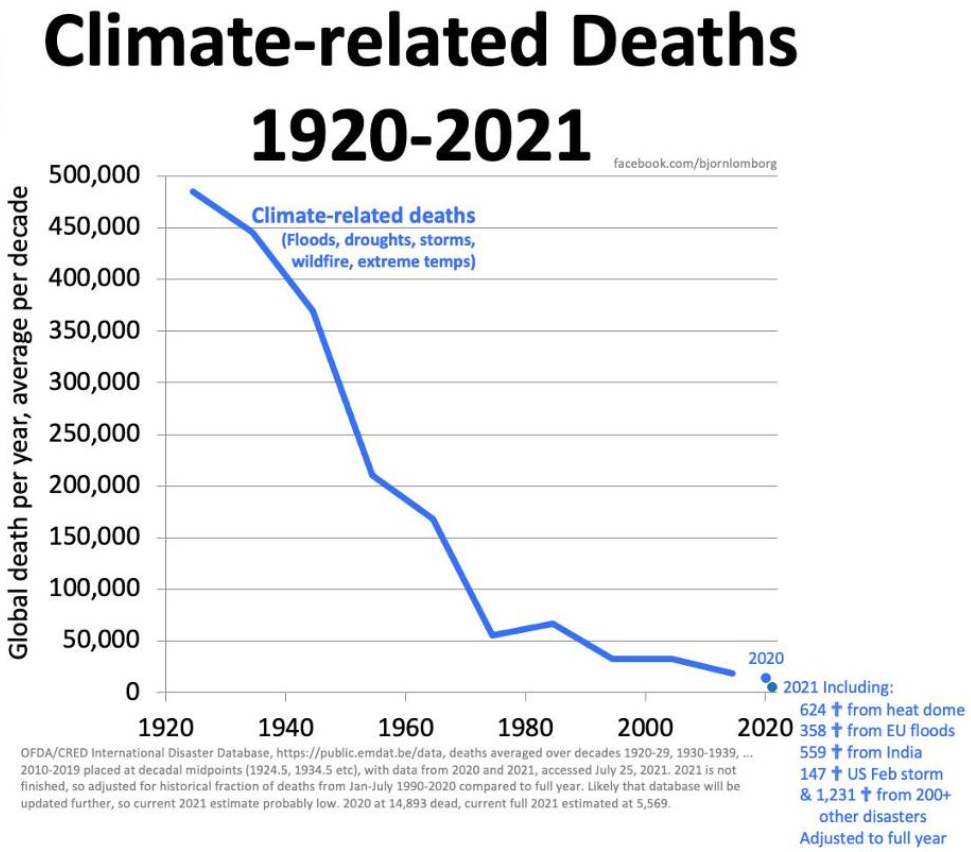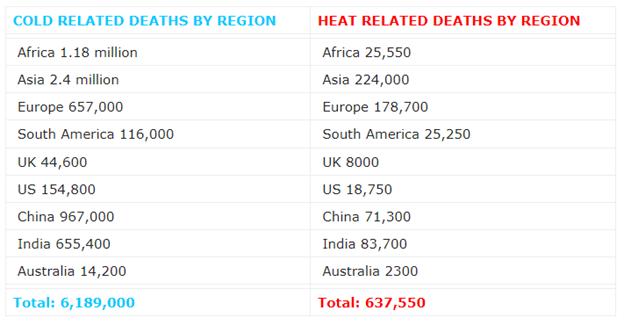Wrong, European Sting, Human Health Is Not Being Compromised by Climate Change
A recent article posted to The European Sting, claims that human health worldwide is threatened by climate change, listing six areas of concern from heat related illness to extreme weather and mental health. These claims are false. People are undoubtedly impacted by bad weather and illnesses, as they always have been, but data refutes claims that human emissions of carbon dioxide have caused an increase in the number or severity of extreme weather events or is harming human health in other ways.
Written by Rutvik Raval, the article titled “Climate Change – The Biggest Health Threat Facing Humanity,” lists six categories of health-related alleged impacts of climate change. These include rising temperatures and heat related illness, expansion of vector-borne diseases, water scarcity and waterborne disease, air pollution and respiratory health, food security and malnutrition, extreme weather events and mental health. Raval especially focuses attention on how climate change is impacting human health in India. For the sake of brevity, Climate Realism will only address four of the six claims Raval makes.
Raval’s assertion that climate change is making air pollution worse is simply untenable, unsupported in theory and fact.
His assertion that climate change in increasing mental health problems has been thoroughly refuted at Climate Realism previously, here, for example, in posts which indicate that to the extent people are being psychologically traumatized, it is not by climate change itself but by the inaccurate, fearmongering which attributes everything negative to climate change. Raval’s European Sting story is a perfect example of something all too common, presenting an alarming narrative about the unproven climate catastrophes attributed, without any scientific evidence, to human fossil use. If anything related to climate change is compromising the psychological well-being of people, youths especially, it is constant bombardment of them with fatalistic climate doom mongering by the mainstream media and social media platforms.
In Raval’s first category, “Rising Temperatures and Widespread Heat-Related Illnesses,” he claims rising temperatures have caused more frequent, intense heatwaves, leading to more heat stroke and similar illnesses, “resulting in a surge of hospitalizations and fatalities in various regions.”
In reality, multiple studies in The Lancet have shown that global deaths due to weather-related events have declined dramatically over time, as discussed in Climate Realism here, here, and here, for example. (See Figure 1 below)

Further, out of deaths related to non-optimum temperatures, research consistently shows that deaths due to cold temperatures vastly outnumber those tied to heat. As a result, as the Earth has modestly warmed, the number of deaths from cold temperatures has fallen dramatically, with only a statistically insignificant increase in the number of deaths attributable to non-optimum heat. The same trend is true of India, the nation Raval focuses most of his attention on. Mortality data show that 8 times as many people are killed by cold temperatures (655,400 people) than hot temperatures (83,700) in India. (See figure 2 below)

In India, record breaking cold has repeatedly occurred in recent years, with little media attention. Meanwhile, record heat has been mostly isolated to major population centers, which suggests that the urban heat island effect may be at play there.
Raval’s second category, “The Expansion of Vector-Borne Diseases,” claims that climate change “altered the geographic distribution of disease-carrying vectors, such as mosquitoes and ticks, causing diseases like malaria, dengue, and chikungunya to spread to new areas.” Data refutes this claim. As explained very recently in “Stop Misinforming about Malaria’s Spread, Washington Post,” dozens of peer reviewed studies show that model-based fearmongering studies about malaria and other diseases are just speculation. Disease carrying insects have long had a widespread distribution, and in many countries where they diseases like malaria were once common, it is now virtually non-existent due to modern responses. India’s climate is perfect for disease carrying mosquitos, and malaria and other vector borne disease have long been endemic there. Nothing has changed in this regard as the Earth has modestly warmed. With the introduction of modern preventative technologies and treatments, incidences and deaths from such diseases have declined dramatically there, as elsewhere.
Concerning Raval’s third category of harms, “Water Scarcity and Waterborne Diseases,” he claims that changes in precipitation, worse drought, and “shifting hydrological cycles” have led to water scarcity around the world, as well as more exposure to contaminated water sources. Right away, the issue of clean water is an infrastructure problem, not a climate problem. Second, the U.N. Intergovernmental Panel on Climate Change reports “high confidence” that precipitation has increased over the mid-latitudes of the Northern Hemisphere, but has only low confidence that there are any signs of decreasing precipitation globally.
Next, Raval discusses “Food Security and Malnutrition Challenges,” claiming that climate change has damaged “agricultural systems and reduce crop yields, jeopardizing global food security.” This is outright false. As dozens of articles published at Climate Realism have demonstrated, food production has increased dramatically amid climate change rather than being threatened by it. As the Earth has warmed, every major crop category has seen increasing yields and production globally, in large part due to the fertilization effect of increased carbon dioxide concentrations. CO2 is plant food.
Areas and regions continue to periodically experience bad weather that on occasion disrupt harvests, as they have throughout history, and they will continue to do so. Climate change is not increasing the number of incidences of bad weather hampering crop production. Indeed, by lengthening the growing season and reducing incidences of late season frosts, it has contributed to improved yields. India is no exception to this truth, for instance, sugar crops have seen increasing yields and rice, corn, and wheat production have skyrocketed during the recent period of modest warming.
Finally, Raval claims that climate change is impacting “Extreme Weather Events and Mental Health Worldwide,” where he says the world has experienced “an uptick in extreme weather events, including floods, cyclones, and droughts, which have become more frequent and severe[.]”
This is also false. The IPCC admits there is little to no evidence that flooding is getting worse, or that climate change is impacting it. It is just as likely that climate change is making flooding less frequent and less severe. Regarding tropical cyclones, the data is even more damaging to Raval’s claims. Global tropical cyclones have not increased over time, and in fact, recent Accumulated Cyclone Energy (ACE) data shows ACE is lower today than it was in the 1970s, meaning these storms have not become more powerful. Data from India show no trend of increasing or decreasing monsoon seasons.
Since extreme weather is neither happening more frequent or becoming more severe, it can’t be causing an increase in mental health problems.
In the end, there is no data supporting the claim that climate change is worsening human health for the six types of health-related impacts Raval and The European Sting discuss, or any other types of health impacts alarmists in the mainstream media, on social media, or in the specialty press try to attribute to it. Concerning climate change and human health, the truth is just not that alarming; an inconvenient fact for the climate crisis narrative.


